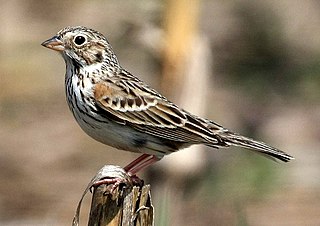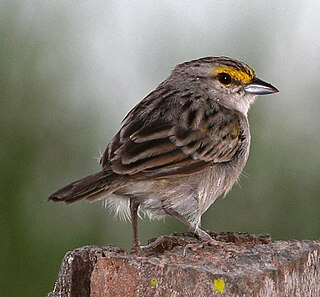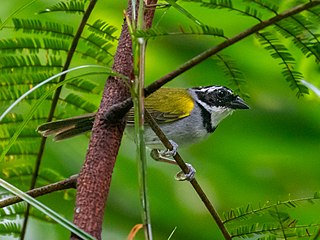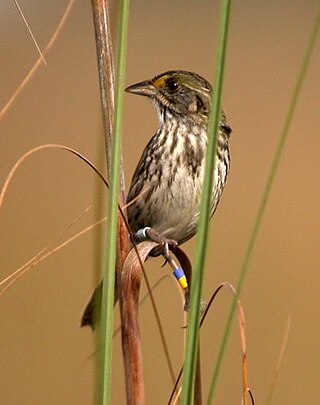
The buntings are a group of Old World passerine birds forming the genus Emberiza, the only genus in the family Emberizidae. The family contains 45 species. They are seed-eating birds with stubby, conical bills.

The white-throated sparrow is a passerine bird of the New World sparrow family Passerellidae. It breeds in northern North America and winters in the southern United States.

Pipilo is a genus of birds in the American sparrow family Passerellidae. It is one of two genera containing birds with the common name towhee.

The vesper sparrow is a medium-sized New World sparrow. The only member of the genus Pooecetes, it is a pale sparrow with brown streaks that breeds across the grasslands of northern North America. It migrates to winter in the southern United States and Mexico.

LeConte's sparrow, also known as LeConte's bunting, is one of the smallest New World sparrow species in North America.

A junco, genus Junco, is a small North American bird in the New World sparrow family Passerellidae. Junco systematics are still confusing after decades of research, with various authors accepting between three and twelve species. Despite having a name that appears to derive from the Spanish term for the plant genus Juncus (rushes), these birds are seldom found among rush plants, which prefer wet ground, while juncos prefer dry soil.

The genus Spizella is a group of American sparrows in the family Passerellidae.

Ammodramus is a genus of birds in the family Passerellidae, in the group known as American sparrows. Birds of this genus are known commonly as grassland sparrows. The name Ammodramus is from the Greek for "sand runner".

Passerculus is a genus of birds that belongs to the New World sparrow family Passerellidae. While formerly considered to include just the Savannah sparrow, recent studies by Birdlife International indicate 3 Savannah sparrow subspecies should promoted to separated species, as result, that there 4 species in the genus. Species found in this genus include:

The dusky seaside sparrow was a non-migratory subspecies of the seaside sparrow, found in Florida in the natural salt marshes of Merritt Island and along the St. Johns River. The last definite known individual died on Walt Disney World's Discovery Island in 1987, and the subspecies was officially declared extinct in December 1990.

Zonotrichia is a genus of five extant American sparrows of the family Passerellidae. Four of the species are North American, but the rufous-collared sparrow breeds in highlands from the extreme southeast of Mexico to Tierra del Fuego, and on Hispaniola.

The seaside sparrow is a species of American sparrow.

New World sparrows are a group of mainly New World passerine birds, forming the family Passerellidae. They are seed-eating birds with conical bills, brown or gray in color, and many species have distinctive head patterns.

Arremon is a genus of neotropical birds in the family Passerellidae. With the exception of the green-striped brushfinch which is endemic to Mexico, all species are found in South America, with a few reaching Central America.

The pectoral sparrow is a species of bird in the family Passerellidae. It is found in Bolivia, Brazil, Colombia, French Guiana, Guyana, Peru, Suriname, and Venezuela. Its natural habitat is subtropical or tropical moist lowland forests. The Brazilian name for this species is tico-tico-de-bico-preto, which in translation means "black billed sparrow".

Atlapetes is a genus of birds in the New World sparrow family Passerellidae. The species are mainly found in montane forest from Mexico to northwestern Argentina.
Scott's seaside sparrow is a subspecies of the seaside sparrow. It was originally thought to be a separate species but later reconsidered as a subspecies of the seaside sparrow.

The Cape Sable seaside sparrow is a subspecies of the seaside sparrow, a species of bird in the family Passerellidae native to the United States. This subspecies is endemic to southern Florida. It is designated endangered under the Endangered Species Act.

Peucaea is a genus of American sparrows. The species in this genus used to be included in the genus Aimophila.

The saltmarsh sparrow is a small New World sparrow found in salt marshes along the Atlantic coast of the United States. At one time, this bird and the Nelson's sparrow were thought to be a single species, the sharp-tailed sparrow. Because of this, the species was briefly known as the "saltmarsh sharp-tailed sparrow." Saltmarsh sparrow numbers are declining due to habitat loss largely attributed to human activity.


















